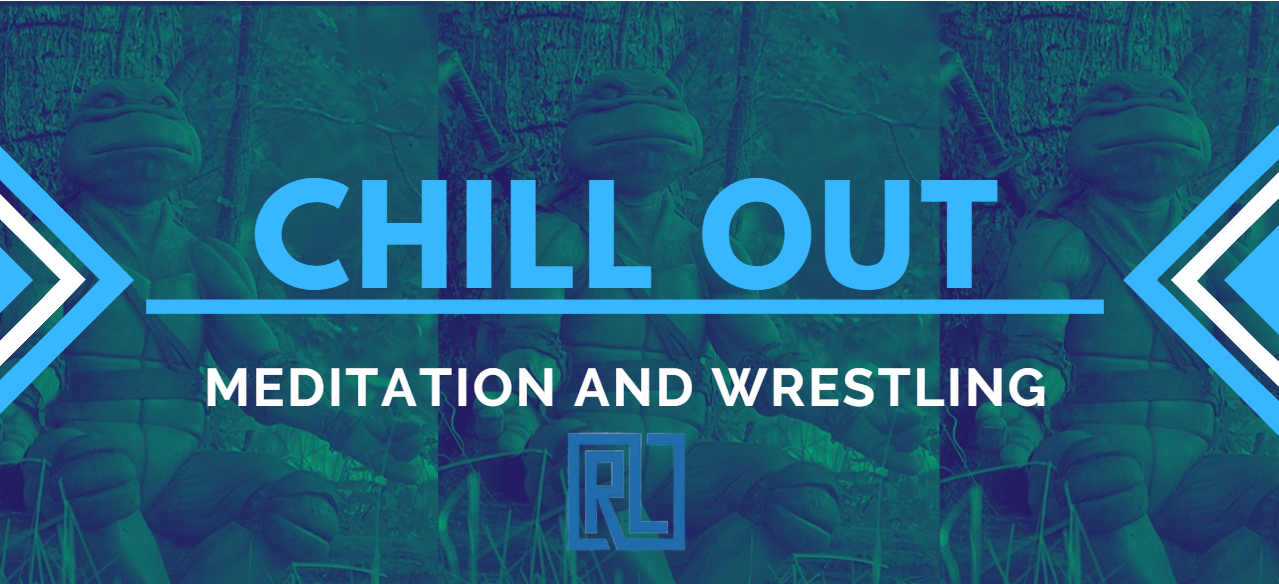|
The idea of meditation (or mindfulness) can be off-putting to a wrestler. But to excel at the sport, you're going to need to learn new tasks over time. Meditation can help. Sports meditation techniques are intended to relax the athletes' bodies and minds while increasing their ability to focus on performance. By raising their awareness through meditation, athletes can direct more attention to learning when necessary, leading to quicker improvement. Also, meditation can increase the total attention span of the athlete and improve vigilance. These benefits combine to really improve awareness and retention while learning the movements and techniques related to your sport. Meditation can have a tremendous impact on our nervous system and our health. Still, it can help us become more self-aware and intentional. Many of us are not in touch with what we're thinking and feeling. As a result, there's no pause before we react to situations. Meditation can allow us to observe our thoughts and feelings. We can get to know ourselves, and, equally importantly, we can learn to gently guide ourselves back to our breath. This allows us to nurture awareness and build our capacity for choice. The result is changed attitudes and behavior that not only benefit us but those around us. Our relationships with family, friends, and even coworkers can begin to change. Visualization can be achieved easily through meditation. During visualization, the brain sends out low levels of impulses through the nerves to the muscles activated in one's imagination. This low-level nerve encourages help to establish a mental blueprint of what is required to perform an activity, making the movement easier to execute. For an athlete to achieve optimal performance, a state of 'flow' is often desired. Flow is a mental state where the mind tunes out all other distractions and focuses solely on it. Again, here is where meditation shines. Those who practice meditation regularly can better and more quickly move into the flow state during physical activity, thanks in part due to high alpha rhythms in the brain, which help suppress distractions. In addition to helping enhance the flow state, high alpha rhythms may also be beneficial for pain management, and yet again serve the athlete in training. The best way to put yourself in the zone with any regularity is to train yourself mentally using meditation. Athletes' flow dispositions and mental skills adoption could be differentiated using mindfulness. It appears that meditating for 20 minutes each day is enough to level for athletes to quickly return to this flow zone state and optimize their performance. It is usual for every wrestler to gain bruises and pain every after training and tournament itself. It takes time to heal and recover, but by practicing meditation, the recovery period speeds up compared to an athlete who doesn't meditate. How? The recovery period works well during sleep/rest sessions. By practicing meditation, athletes can have enough amount of sleep without experiencing insomnia or other distractions. It is proven that meditation can boost the immune system, preventing injury and illness that can affect training and performance. Being relaxed and centered improves focus and concentration and increases the ability to remain calm under pressure. By consistently practicing meditation, your body will learn how to relax in stressful situations, building self-confidence, and ultimately achieving a more positive mindset. When you can effectively train yourself to control your attention and place it on task-relevant items, you will find that your focus will increase. In-game engagement will be higher, and you will be much more convincing. People with more mindful traits can better stabilize their emotions and better control their moods. This is essentially the basis of resiliency. Humans have the propensity to run obsessive thoughts through our minds. Meditation has been shown to reduce rumination. Meditation will essentially help an athlete be aware of thoughts without attachment creating the option to reset their minds and focus on the present. Athletes who practice meditation consistently can help their bodies recover quicker from training, wrestling, and even injury. While physical exercise is good, it also places high levels of stress on the body, including muscle fiber tears. Meditation can reduce recovery time from many common sports injuries. Also, it boosts the immune system, preventing illnesses that could hinder training and/or performance. Researchers from the University of Wisconsin School of Medicine and Health found that those who practice meditation experience fewer acute respiratory infections and a shortened duration and severity of symptoms from the common cold. Fears can hijack our minds. Meditation has been shown to help calm the amygdala – the brain's fear center, even when not meditating. The simple act of having a daily practice of meditation enables our minds to effectively deal with life fears. Meditation in sport can help athletes conquer those common "blind spots" that make performance challenges seem more complicated. These blind spots negatively impact performance, and meditation enables you to recognize your blind spots. Meditation in sport can significantly improve the mind-body connection, allowing you to discover your optimal performance zone. Wrestlers are always dealing with some pain. High endurance sports do a number to the body. Meditation has been shown to help people cope with pain. Types of Meditation Mindfulness The first is simple mindfulness, were you calm and relaxed your mind. With this one, you'll calm your thoughts by focusing your attention on one anchor thought, learning how to tune out any other distractions. This anchor should be something peaceful and soothing, such as the sound of a waterfall or even just your own breath. As you hold this, you will find that other thoughts come to mind, so your job is to dismiss them from consciousness. Suppose you see one study is regularly occurring. In that case, it's then time to address why it is so important and how you can effectively deal with it. As we develop mindfulness, we may become aware of a lot of negative self-talk. When we come from a home with toxic stress, we can improve a less-than-optimistic outlook on life. We can have feelings of shame or experience low self-esteem. But these attitudes can be transformed. Active Meditation The next variation is more in tune with most athletes and involves using activity to free their minds. You'll go about some form of physical activity such as wrestling and focusing only on the muscles contracting, your body taking in oxygen, and the movement's feeling. As you do this, focus on tuning out all other thoughts that are coming into play. Guided Meditation Guided meditation is used most when you want to perform imagery and is where you will create a specific scene in your mind. You are literally guiding your thought processes through the situation, altering the results you hope they will come about. So, there you have the necessary information on why meditation can serve to benefit any athlete along with their usual training routine. Do not underestimate the power that this form of activity has to offer. With just a short amount of time each day devoted to practicing, you can see noticeable improvements in your performance. Meditation can be difficult. While we know it's transformative, it may not be for you. At least not yet. Now, meditation may surface traumatic events that we're not ready to handle right now. Reassure yourself that you are essential. Know that many alternative practices can feel safe and soothe our nervous systems and rewire our thinking, such as guided meditation, relaxation, yoga, and breathing exercises. How to Meditate
(Full disclosure, Zen Warrior Mindset is a program designed for wrestlers to learn how to utilize meditation strategies. Creator Ross Lewin is way better versed in this topic, and you should reach out to him for a more detailed program.) Mindful meditation, or focused breathing, takes steadfast concentration. You're focusing on each deep breath as if a loved one's life is depending on your being fully connected to that breath. But do it first thing before you open your computer or brush your teeth or make coffee—do mindful breathing. Start with just three minutes, then add three minutes until you top out at 20. Morning is ideal. It helps to establish that inner space before you start running at full speed. If you wait, you might just run out of momentum, interest, and willpower. Here is a rundown:
As with all fitness, when you're practicing mindful meditation, the breathing is all about proper technique. Start in your stomach, let your diaphragm pop out, and then move your breathing all the way up to the back of your chest. You'll feel a little tension at the top before a long exhale. And then sit at the bottom of that exhale while your mind is fully connected to what's happening. And then do it again. Set the time on your phone and just breathe. When your mind wanders, just gently recognize that you're away from your breath, and gently refocus all your attention back to your breathing: the inhale, the exhale, the sensations of your body. Your mind will be less cloudy with better concentration. Whether you're deadlifting or wrestling at the national finals, practitioners say that your experience meditating will crop up in ways you couldn't have imagined. Once you've honed the discipline of streamlining your thoughts and focusing intently on the present moment, your athletic performance will inexorably improve. From an athletic standpoint, when we have increased awareness, we can adjust with greater ease. If you're staring at that barbell, mindfulness provides wisdom and insight that will help us let it rip once we're in the moment. You may incorporate visualization at the end of the meditation. Visualization is best when your mind and body are relaxed. After a few minutes of this, meditation is the perfect time to bring it in. Visualize yourself doing your skill in ideal form. Or visualize yourself achieving your goal. For instance, see yourself standing on top of the podium with the gold medal around your neck. Make sure to imagine something you genuinely want in your life because it will happen if you stay committed. Remember, meditation is a practice. It is a method to help you experience more clarity and peace of mind. WORK CITED: Meditation and Combat Sport MEDITATION AND RELAXATION PRACTICES Benefits of Meditation for Fighters | Peak Performance Unlocked How to Meditate: an Athlete’s Guide to Mindful Meditation Meditation For The Athlete: 8 Steps To Get You Started Meditation for Athletes Improves Performance
0 Comments
Leave a Reply. |
AuthorRyan Lancaster wears many hats. Dive into his website to learn about history, sports, and more! Archives
July 2024
Categories |




 RSS Feed
RSS Feed